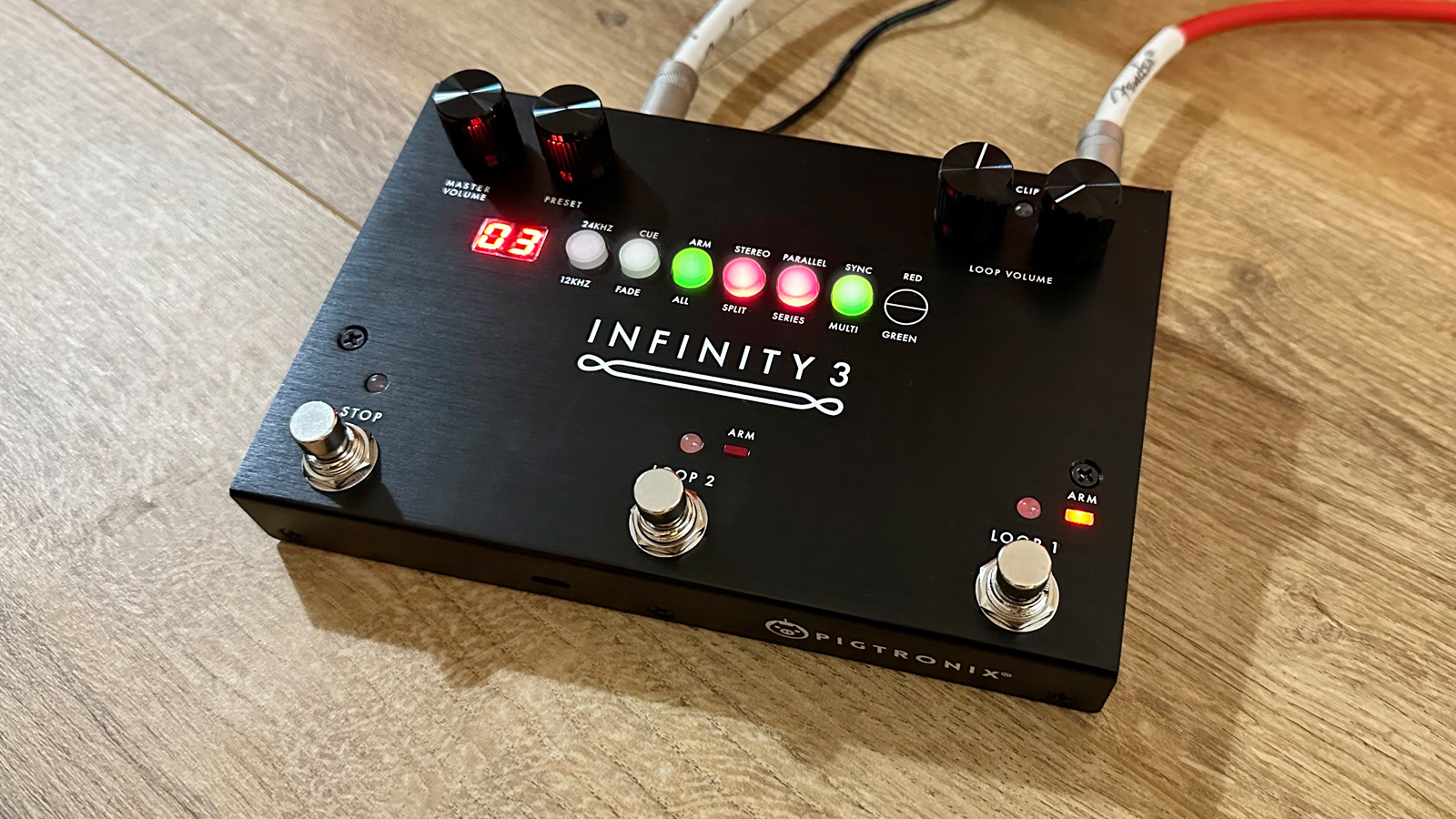Guitar World Verdict
Infinity 3 is intuitive, looks great and is simple to use, yet has enough complexity to appeal to experienced players alike. Easy to recommend.
Pros
- +
Thoughtful layout and design
- +
MIDI sync
- +
Easy to use
Cons
- -
No undo/redo without additional pedal
You can trust Guitar World
It could be argued that looper pedals tend to fall into two camps. There are either loads of features, effects or otherwise or none at all other than the basic record, play and overdub capabilities. Take the TC Ditto, for example, with its single footswitch and lone volume control simplicity, and contrast that with the higher-end Boss RC-600, which has enough lights, switches and controls to make even experienced players break out in cold sweats. Pigtronix, however, believes there should be a middle ground where functionality and ease of use can co-exist.
Its flagship Infinity 3 achieves a nice balance of offering plenty in the way of features and functionality but keeps things user-friendly by laying it out in an accessible, thoughtful way. The clean, uncluttered design of Infinity 3, with one-button-per-function operation and nothing in the way of menu diving, makes it easy to pick and play without requiring a full read of the manual first, yet it’s capable of some interesting things, especially when you start adding MIDI sync into the mix.

The prospect of MIDI-enabled looper pedals isn’t new, but in practice, I’ve only ever found it frustrating to execute. Recent Boss loopers have MIDI capabilities, for example, but getting them set up required a lot of trial and error, and even then I couldn’t say the experience was rock-solid. Infinity 3 does improve things considerably, and I had a lot of fun syncing the Infinity 3 with my Elektron Digitakt groove box. Having everything aligned and in sync opens up incredible creative possibilities, so getting MIDI right is a big tick in the box for Pigtronix.
What frustrated me, on the other hand, was the lack of an on-pedal undo/redo function. Even the most experienced players can sometimes need the safety net of being able to undo a phrase, so not having this basic function available baffled me a bit.
In fairness, you can purchase a separate, external switching pedal and connect it to the rear of the pedal, but for my money, this is a basic must-have quality-of-life tool and it seems strange to omit it.

What can’t be faulted is the build quality of the Infinity 3. This is a hefty, heavyweight pedal that feels made to last. On the face of the pedal, there are rotary knobs to control the volumes of the two individual tracks, along with a knob to scroll through preset configurations – thankfully, you can save your own presets too.
Across the middle, a line of multi-function buttons allows control over the different parameters offered by the pedal, including the ability to change the sample rate of your loop to drop it down an octave (handy for using a regular electric guitar to record a bass line). You can also decide whether you want your loops to run in series or parallel and if the two channels are to be synced or if they can roam independently of each other.
All the latest guitar news, interviews, lessons, reviews, deals and more, direct to your inbox!

Boss RC-500: The flagship Boss looper is hard-to-beat and simple enough for a beginner to get up and running quickly.
Digitech TRIO+: This band in a box pedal is ideal for those looking to jam at home or songwriters seeking a jolt of inspiration.
Electro Harmonix 22500: This dual stereo looper from EHX is flexible, reliable and affordable - what more do you need?
To the back of the pedal, you’ve got all your connectivity, including stereo in and out connections, aux outputs for the loop audio and then your MIDI connection. Important to note the Infinity 3 requires (and thankfully comes with) an 18v power supply, so your usual Boss 9v plug isn’t going to cut it here.
On its website, Pigtronix claims the Infinity 3 is the "world’s most musical looping pedal". After spending some time with it, I’m struggling to square that sentence. That’s not to say Infinity 3 isn’t a good looper – it absolutely is – but the most musical? Perhaps a more apt description would be to say it’s among the most intuitive loopers we’ve tested. Add some stereo looping, a tonne of different configurations for syncing loops and external gear, and superb quality audio thanks for the 48kHz/24-bit depth, and you’ve got an incredible all-around package.
It’s not the cheapest looper pedal in its category, and the lack of a built-in undo/redo function is a shame, but overall Pigtronix has done a great job with Infinity 3.
Specifications
- Record Time: 3 hours
- Audio Quality: Up to 48kHz/24-bit
- Function: Deluxe Stereo Double Looper w/ MIDI
- Expression: TRS 10K or 0-5V CV, TRS Remote, MIDI
- Bypass: Buffered
- Voltage: 18VDC
- Current Draw: 200mA
- Input Impedance: 1M
- Output Impedance: 150ohms
- Dimensions (L x W x H): 5 " x 7.4" x 2.4"
- Weight: 1.2 lbs
- Contact: Pigtronix
Chris Corfield is a journalist with over 12 years of experience writing for some of the music world's biggest brands including Orange Amplification, MusicRadar, Guitar World, Total Guitar and Dawsons Music. Chris loves getting nerdy about everything from guitar gear and synths, to microphones and music production hardware.


